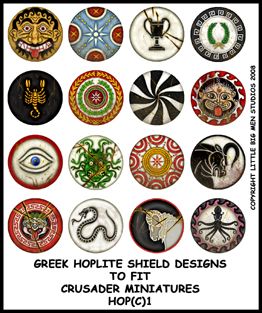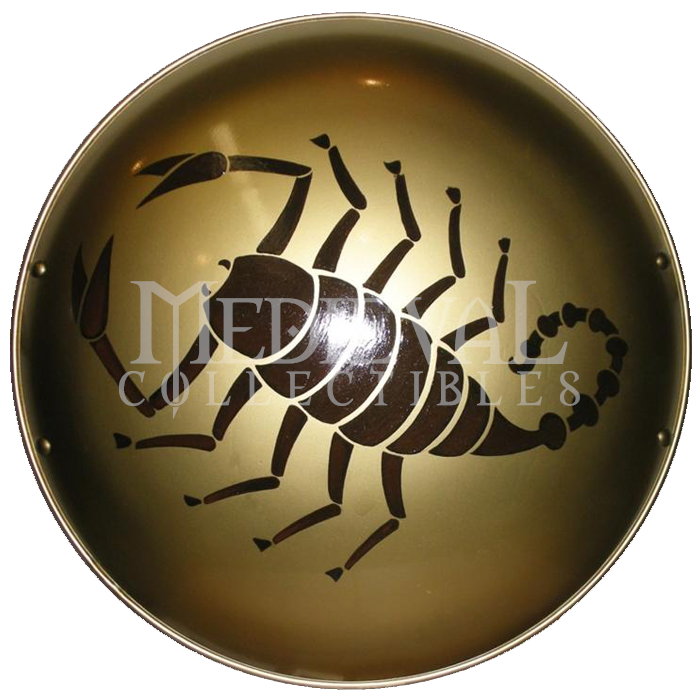

As a result, hoplites usually came from wealthier backgrounds, as poorer Greeks were unable to afford all the required weapons and the costly set of armor. In order to become a hoplite, an assortment of expensive equipment was necessary.
#GREEK HOPLITE SHIELD DESIGN MEANINGS FULL#
A warrior in full hoplite armor was expected to carry around 20 kilograms (44 pounds) in weight, and as a result they had to be extremely physically fit. Armguards were sometimes worn, and as hoplite armor developed the breastplate was reduced in weight and transformed into a laminated linen vest called a linothorax.

On his chest the hoplite wore a breastplate, a thorax, made of bronze or leather, and to protect his legs and shins he used bronze greaves named knemides. The shields would often feature various designs and emblems on the front, such as the Gorgon from Greek mythology or an inverted V-shape which was characteristic of the Spartans.įor protection, the hoplite was fitted with a bronze helmet to safeguard the head, neck, and face, which was lined with leather, and crested with a diverse array of styles. It was made of wood and paneled with bronze, with hoplite soldiers holding a strap called an antilabe located on the edge of the shield and their arm set in place through a central band called a porpax. In his other hand, the hoplite brandished a large round shield known variously as a hoplon or an aspis, which could be 80 centimeters (2.6 feet) in diameter and weighed up to 8 kilograms (18 pounds). (Staatliche Antikensammlungen / Public domain )

The hoplite phalanx is a frequent subject in ancient Greek art. A Jewel in the Aegean: Greeks Used Advanced Engineering to Create a Monumental IslandĪ legendary hoplite or Greek citizen-soldier phalanx fighting on a classical black-figure amphora from circa 560 BC.Gods Throwing Dice: Cleromancy In The Trojan War.An additional dagger, called an encheiredon, would ensure that the hoplite could still protect himself if he found himself in a tricky situation on the battlefield and was unable to use his two main weapons. For more close combat use, they were also equipped with a short-sword called a machaira or kopis which was conventionally just under 60 centimeters (2 feet) long. The first, which enabled hoplites to thrust from a distance, was a long wooden spear, called a doru, which had an average length of 2.5 meters (8.2 feet) and was tipped with a bronze or iron blade and surrounded by a four-pronged spike on its sides called a sauroter. Hoplites or Greek citizen soldiers, were usually armed with three different types of weapons, and each would serve different functions. The phalanx remains one of the most effective tactics ever conceived and was responsible for one of the least likely victories ever accomplished at the Battle of Marathon in 490 BC. Greek hoplites, armed with a variety of weapons and bronze armor, were an incredibly strong military force and innovators of a battlefield formation known as the phalanx.
#GREEK HOPLITE SHIELD DESIGN MEANINGS PROFESSIONAL#
With the exception of Sparta, which had a permanent professional army, ancient Greek civilizations only called up soldiers when absolutely necessary. Hoplite comes from the Greek word “ ta hopla ,” which means “tool” or “equipment,” and was the name given to legions of citizen soldiers who were tasked with protecting their territories from outside challengers. A Celtic knot is a symbolism of something more in-depth. Most people do not know what they mean other than they have unique patterns characterized by infinite knots. Most likely, you have come across Celtic knots, either on jewelry, tattoo shops, a Cross, or in a church.


 0 kommentar(er)
0 kommentar(er)
